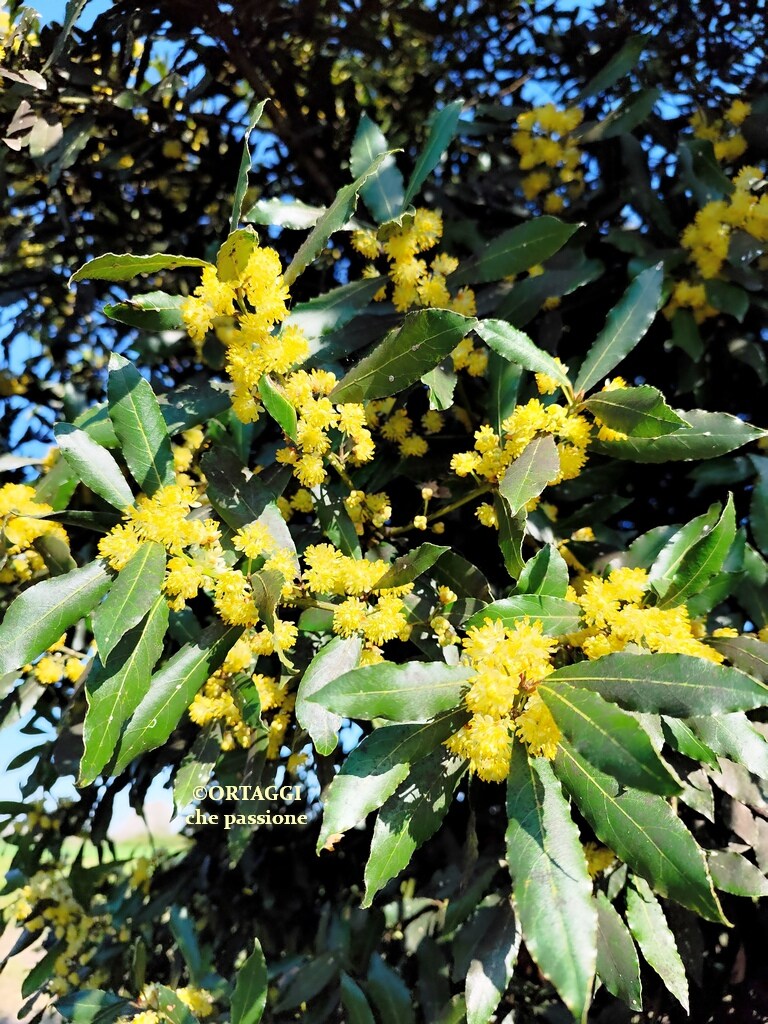The bay flowers are less known than the leaves, but they offer a delicate and slightly spicy aroma, with nuances reminiscent of honey and balsamic herbs. These small, yellow flowers bloom in spring and can be used fresh or dried to enrich sweet and savory dishes. In addition to being appreciated for their fragrance, bay flowers boast digestive and antioxidant properties.
When does the bay plant bloom? In spring, generally between March and May. Its flowers are small, light yellow, and appear in clusters at the leaf axils.
🍀🍀🍀🍀

- Difficulty: Easy
- Cost: Economical
- Cuisine: Healthy
- Seasonality: Spring
- Energy 3.13 (Kcal)
- Carbohydrates 0.75 (g) of which sugars 0.00 (g)
- Proteins 0.08 (g)
- Fat 0.08 (g) of which saturated 0.00 (g)of which unsaturated 0.00 (g)
- Fibers 0.26 (g)
- Sodium 0.23 (mg)
Indicative values for a portion of 10 g processed in an automated way starting from the nutritional information available on the CREA* and FoodData Central** databases. It is not food and / or nutritional advice.
* CREATES Food and Nutrition Research Center: https://www.crea.gov.it/alimenti-e-nutrizione https://www.alimentinutrizione.it ** U.S. Department of Agriculture, Agricultural Research Service. FoodData Central, 2019. https://fdc.nal.usda.gov
Bay Flowers
- 3.5 oz bay flowers (flowers)
When and how to harvest bay flowers?
When to harvest
🍀 Period: spring, during full bloom.
🍀 Time of day: in the morning after the dew has dried, on a sunny day.
How to harvest
🍀 Select open and fragrant flowers, avoiding dry or damaged ones.
🍀 Use clean scissors to cut the stems with the flowers, without tearing them.
🍀 Always leave some flowers on the plant to ensure pollination and berry formation.
Before using fresh bay flowers, let them rest for a few minutes to allow any insects to leave.
Dry flowers should be stored in an airtight jar or container, in a dry and dark place.
How to use the flowers in cooking?
Bay flowers (fresh or dried) can be used in various ways:
🍀 Infusions and teas, to aid digestion.
🍀 Seasoning for soups or stews, for a more delicate aroma than the leaves.
🍀 Marinades and sauces, to flavor legumes and vegetables.
🍀 Sweets, thanks to their sweet notes.
🍀 Flavored honey or salt
🍀 Spiced vinegar or liquor
🍀 They can be used to garnish gourmet dishes
🌿 WARNING
🍀 Do not confuse with similar plants (ensure it’s Laurus nobilis).
🍀 Moderate quantities: the flavor is stronger than the leaves!
Perfect after meals to aid digestion.
Ingredients:
– half a teaspoon of dried bay flowers (1 teaspoon if fresh)
– about 1 cup of water
– Honey or lemon (optional)
Preparation:
Bring the water to a boil.
Add the bay flowers and let them infuse for 5-7 minutes.
Strain and sweeten as desired.Bay tea and contraindications: not recommended during pregnancy, lactation, and for those with allergies or gastrointestinal disorders, such as ulcers or gastritis, as it may irritate the mucosa.
A fragrant broth ideal for soups or risottos.
Ingredients:
– 1 onion
– 1 carrot
– 1 celery stalk
– 1 teaspoon of dried bay flowers (2 teaspoons if fresh)
– Salt
– about 4 cups of water
Preparation:
Chop the vegetables and put them in a pot with the water.
Add the bay flowers and bring to a boil.
Cook for 30-40 minutes, then strain and use as desired.A flavored honey perfect for sweetening desserts, creams, or yogurt.
Ingredients:
– 7 oz of honey (preferably multi-flower)
– 1 teaspoon of dried bay flowers
Preparation:
Add the bay flowers to the honey and mix well.
Let rest for at least a week in a closed jar.
Use the flavored honey for sweetening or seasoning.A delicate and fragrant condiment, perfect for salads, marinades, and vegetable dishes.
Ingredients:
– about 2 cups of apple cider or white wine vinegar
– 2 tablespoons of dried bay flowers (or 4 tablespoons of fresh flowers)
Preparation:
Pour the vinegar into a clean glass jar.
Add the bay flowers and mix well.
Seal tightly and let rest in a cool, dark place for at least 2 weeks.
Shake the jar every few days to aid infusion.
After the resting time, strain the vinegar with a fine mesh strainer or cheesecloth.
Transfer to a clean bottle and store in the pantry.
Usage:
Perfect for flavoring salads, marinating grilled vegetables, or adding an aromatic touch to sauces and dressings.An aromatic digestive to savor after meals.
Ingredients
– about 2 cups of 95° food alcohol
– 4 tablespoons of dried bay flowers
– about 2 cups of water
– 10.5 oz of sugar
Preparation:
Place the bay flowers in the alcohol and let them macerate for 10 days in a closed jar.
After this time, prepare a syrup by dissolving the sugar in hot water.
Strain the alcohol and mix it with the cooled syrup.
Pour the liquor into a bottle and let it rest for at least 15 days before consuming.
Tip:
Serve very cold to enhance the flavor!
Why isn’t my bay tree flowering?
🍀 Plant age: younger specimens (under 3-5 years) rarely flower.
🍀 Inappropriate climate: temperatures too low or insufficient sun exposure (less than 6 hours/day).
🍀 Incorrect pruning: drastic cuts or at the wrong time (e.g., late summer) remove flower buds.
🍀 Poor soil: lack of phosphorus and potassium, or excess nitrogen that only favors leaves.
🍀 Water: waterlogging or prolonged droughts compromise flowering.
🍀 Sterile variety: some specimens (especially from cuttings) flower little or not at all.
BENEFITS of bay
The nutritionist Amoroso says: “A precious source of vitamins (A, C) and folic acid, as well as magnesium and calcium; it has marked beneficial properties for the digestive system, as it helps alleviate symptoms of ulcers and gastritis and contributes to intestinal well-being by limiting bloating and fermentation processes. It is also very useful during the cooking of legumes, helping to make them more digestible and to limit the intestinal bloating that often accompanies their consumption.“
How do you distinguish good bay from poisonous bay?
The good bay (Laurus nobilis), used in cooking, is distinguished from poisonous bay (Prunus laurocerasus) by several key details:
Leaves: Edible bay has long, thin leaves that smell of spices when rubbed. Poisonous bay has broader, shiny leaves that, when broken, emit a bitter almond scent (a sign of toxic hydrocyanic acid).
Flowers and fruits: Good bay has small yellow flowers and black berries, while cherry laurel has white cluster flowers and highly toxic dark berries.Is fresh bay toxic?
Fresh bay is safe in cooking, just wash it well, use a few leaves (they are very aromatic), and remove them before serving.
What is the difference between female bay and male bay?
The bay (Laurus nobilis) is a dioecious plant, meaning there are separate male and female specimens. The main difference is in flowering and fruit production:
Male bay: Produces yellow flowers with only stamens, so it does not fruit. Its flowers are more numerous and often more showy.
Female bay: Has less conspicuous flowers but, after pollination, develops the typical black or purple berries in autumn.
Both have aromatic leaves and can be used in cooking without differences.

